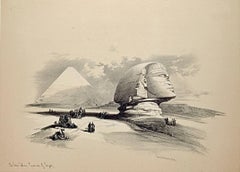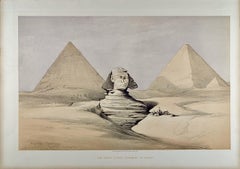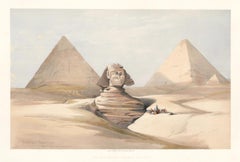David Roberts Sphinx
1840s Realist Landscape Prints
Lithograph
1840s Realist Landscape Prints
Lithograph
Recent Sales
1840s Landscape Prints
Paper
People Also Browsed
21st Century and Contemporary Italian Mid-Century Modern Table Lamps
Brass
21st Century and Contemporary American Victorian Taxidermy
Glass
Vintage 1950s English Victorian Books
Leather, Paper
Antique 19th Century English Rococo Sterling Silver
Sterling Silver
20th Century Taxidermy
Glass, Wood
2010s Contemporary Black and White Photography
Photographic Paper, Polaroid, Color, C Print, Archival Paper
Kirsten Thys van den AudenaerdeGirl - Contemporary, Nude, Women, Polaroid, 21st Century, Color, 2019
20th Century French Nautical Objects
Bronze
2010s Italian Dinner Plates
Ceramic
Antique 1890s French Cigar Boxes and Humidors
Wood
2010s American Decorative Art
Limestone
1840s Realist Landscape Prints
Lithograph
1840s Realist Landscape Prints
Lithograph
1840s Realist Landscape Prints
Lithograph
Antique Early 19th Century Italian Natural Specimens
Coral, Silver
20th Century American Regency Musical Instruments
Bronze, Ormolu
1960s Figurative Photography
Color, Dye Transfer
David Roberts Sphinx For Sale on 1stDibs
How Much is a David Roberts Sphinx?
David Roberts for sale on 1stDibs
David Roberts was born outside of Edinburgh, Scotland. At age 10 he became a house painter’s apprentice. He continued painting houses and, eventually, theater scenes in Edinburgh and then in London. Roberts’ friend, J.M.W. Turner, recognized his artistic talent and encouraged him to become a full-time artist.
In 1839 Roberts traveled to Egypt and then in 1840, through the Holy Land, concluding in Jerusalem. Upon his return to England, F.G. Moon agreed to publish lithographs created by Louis Haghe from Roberts’ sketches and watercolors. This publication was highly acclaimed and very popular for its esthetic quality, its historical and topographical accuracy, and Roberts’ dramatic depiction of his scenes. Queen Victoria and Charles Dickens were among the subscribers who collected his works. Roberts’ and Haghe’s duotone lithographs, often colored, remain extremely sought after today and have been rising steadily in value.
Find original David Roberts paintings and prints on 1stDibs.
Finding the Right Prints-works-on-paper for You
Decorating with fine art prints — whether they’re figurative prints, abstract prints or another variety — has always been a practical way of bringing a space to life as well as bringing works by an artist you love into your home.
Pursued in the 1960s and ’70s, largely by Pop artists drawn to its associations with mass production, advertising, packaging and seriality, as well as those challenging the primacy of the Abstract Expressionist brushstroke, printmaking was embraced in the 1980s by painters and conceptual artists ranging from David Salle and Elizabeth Murray to Adrian Piper and Sherrie Levine.
Printmaking is the transfer of an image from one surface to another. An artist takes a material like stone, metal, wood or wax, carves, incises, draws or otherwise marks it with an image, inks or paints it and then transfers the image to a piece of paper or other material.
Fine art prints are frequently confused with their more commercial counterparts. After all, our closest connection to the printed image is through mass-produced newspapers, magazines and books, and many people don’t realize that even though prints are editions, they start with an original image created by an artist with the intent of reproducing it in a small batch. Fine art prints are created in strictly limited editions — 20 or 30 or maybe 50 — and are always based on an image created specifically to be made into an edition.
Many people think of revered Dutch artist Rembrandt as a painter but may not know that he was a printmaker as well. His prints have been preserved in time along with the work of other celebrated printmakers such as Pablo Picasso, Salvador Dalí and Andy Warhol. These fine art prints are still highly sought after by collectors.
“It’s another tool in the artist’s toolbox, just like painting or sculpture or anything else that an artist uses in the service of mark making or expressing him- or herself,” says International Fine Print Dealers Association (IFPDA) vice president Betsy Senior, of New York’s Betsy Senior Fine Art, Inc.
Because artist’s editions tend to be more affordable and available than his or her unique works, they’re more accessible and can be a great opportunity to bring a variety of colors, textures and shapes into a space.
For tight corners, select small fine art prints as opposed to the oversized bold piece you’ll hang as a focal point in the dining area. But be careful not to choose something that is too big for your space. And feel free to lean into it if need be — not every work needs picture-hanging hooks. Leaning a larger fine art print against the wall behind a bookcase can add a stylish installation-type dynamic to your living room. (Read more about how to arrange wall art here.)
Find fine art prints for sale on 1stDibs today.


